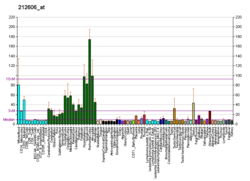From Wikipedia, the free encyclopedia
Protein-coding gene in the species Homo sapiens
WD repeat and FYVE domain-containing protein 3 is a protein that in humans is encoded by the WDFY3 gene .[5] [6]
This gene encodes a protein which contains WD repeats and an FYVE domain . Multiple alternatively spliced transcript variants have been found for this gene, but the full-length nature of some variants has not been defined.[6]
Biochemistry [ edit ] This protein appears to act as a autophagy scaffolding protein.[7]
Clinical [ edit ] Mutations in this gene have been associated with neurodevelopmental delay, intellectual disability, macrocephaly and psychiatric disorders (autism spectrum disorders/attention deficit hyperactivity disorder ).[7]
References [ edit ]
^ a b c GRCh38: Ensembl release 89: ENSG00000163625 – Ensembl , May 2017^ a b c GRCm38: Ensembl release 89: ENSMUSG00000043940 – Ensembl , May 2017^ "Human PubMed Reference:" . National Center for Biotechnology Information, U.S. National Library of Medicine .^ "Mouse PubMed Reference:" . National Center for Biotechnology Information, U.S. National Library of Medicine .^ Nagase T, Ishikawa K, Suyama M, Kikuno R, Hirosawa M, Miyajima N, Tanaka A, Kotani H, Nomura N, Ohara O (Jul 1999). "Prediction of the coding sequences of unidentified human genes. XIII. The complete sequences of 100 new cDNA clones from brain which code for large proteins in vitro" . DNA Res . 6 (1): 63–70. doi :10.1093/dnares/6.1.63 PMID 10231032 . ^ a b "Entrez Gene: WDFY3 WD repeat and FYVE domain containing 3" .^ a b Le Duc D, Giulivi C, Hiatt SM, Napoli E, Panoutsopoulos A, Harlan De Crescenzo A, Kotzaeridou U, Syrbe S, Anagnostou E, Azage M, Bend R, Begtrup A, Brown NJ, Büttner B, Cho MT, Cooper GM, Doering JH, Dubourg C, Everman DB10, Hildebrand MS12,17, Santos FJR, Kellam B, Keller-Ramey J, Lemke JR, Liu S11, Niyazov D, Payne K, Person R, Quélin C, Schnur RE, Smith BT, Strober J, Walker S, Wallis M, Walsh L, Yang S, Yuen RKC, Ziegler A, Sticht H, Pride MC, Orosco L, Martínez-Cerdeño V, Silverman JL, Crawley JN, Scherer SW, Zarbalis KS, Jamra R (2019) Pathogenic WDFY3 variants cause neurodevelopmental disorders and opposing effects on brain size. Brain
Further reading [ edit ]
Nakajima D, Okazaki N, Yamakawa H, et al. (2003). "Construction of expression-ready cDNA clones for KIAA genes: manual curation of 330 KIAA cDNA clones" . DNA Res . 9 (3): 99–106. doi :10.1093/dnares/9.3.99 PMID 12168954 . Andersson B, Wentland MA, Ricafrente JY, et al. (1996). "A "double adaptor" method for improved shotgun library construction". Anal. Biochem . 236 (1): 107–13. doi :10.1006/abio.1996.0138 . PMID 8619474 . Yu W, Andersson B, Worley KC, et al. (1997). "Large-scale concatenation cDNA sequencing" . Genome Res . 7 (4): 353–8. doi :10.1101/gr.7.4.353 . PMC 139146 PMID 9110174 . Sanger Centre, The; Washington University Genome Sequencing Cente, The (1999). "Toward a complete human genome sequence" . Genome Res . 8 (11): 1097–108. doi :10.1101/gr.8.11.1097 PMID 9847074 . Strausberg RL, Feingold EA, Grouse LH, et al. (2003). "Generation and initial analysis of more than 15,000 full-length human and mouse cDNA sequences" . Proc. Natl. Acad. Sci. U.S.A . 99 (26): 16899–903. Bibcode :2002PNAS...9916899M . doi :10.1073/pnas.242603899 PMC 139241 PMID 12477932 . Ota T, Suzuki Y, Nishikawa T, et al. (2004). "Complete sequencing and characterization of 21,243 full-length human cDNAs" . Nat. Genet . 36 (1): 40–5. doi :10.1038/ng1285 PMID 14702039 . Simonsen A, Birkeland HC, Gillooly DJ, et al. (2005). "Alfy, a novel FYVE-domain-containing protein associated with protein granules and autophagic membranes" . J. Cell Sci . 117 (Pt 18): 4239–51. doi :10.1242/jcs.01287 PMID 15292400 . Gerhard DS, Wagner L, Feingold EA, et al. (2004). "The status, quality, and expansion of the NIH full-length cDNA project: the Mammalian Gene Collection (MGC)" . Genome Res . 14 (10B): 2121–7. doi :10.1101/gr.2596504 . PMC 528928 PMID 15489334 . Hillier LW, Graves TA, Fulton RS, et al. (2005). "Generation and annotation of the DNA sequences of human chromosomes 2 and 4" . Nature . 434 (7034): 724–31. Bibcode :2005Natur.434..724H . doi :10.1038/nature03466 PMID 15815621 .







